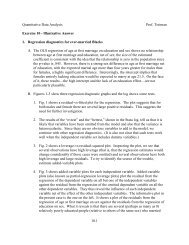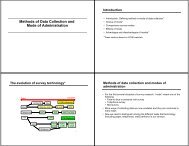2.1 Quantitative Data Analysis Prof. Treiman Exercise 2: Illustrative ...
2.1 Quantitative Data Analysis Prof. Treiman Exercise 2: Illustrative ...
2.1 Quantitative Data Analysis Prof. Treiman Exercise 2: Illustrative ...
- No tags were found...
You also want an ePaper? Increase the reach of your titles
YUMPU automatically turns print PDFs into web optimized ePapers that Google loves.
<strong>Quantitative</strong> <strong>Data</strong> <strong>Analysis</strong><strong>Prof</strong>. <strong>Treiman</strong><strong>Exercise</strong> 2: <strong>Illustrative</strong> Answer1.a.To reconstruct the two variable table “Tolerance by Sex”:Step 1:Step 2:Step 3:Convert the percentages in each row to frequencies. For example, 12 percentof 249 is 29.9, round this to 30. Fifty four percent of 249 is 134. Thirty fourpercent of 249 is 85. As a check, add 30 + 134 + 85 = 249. Convert theremaining rows in the same way.Add the six sets of frequencies for males, category by category. Do the samefor females.Percentage the two resulting frequency distributions to obtain the left-handpanel of Table A.Repeat Steps 1-3 to obtain the frequency distributions in the left-hand panels of Tables Band C.As an aid to discussing the relationships between each of the independent variables andtolerance controlling for the effect of the other two independent variables, I recommendcomputing the corresponding standardized distributions. These are shown in the righthandpanel of each table (how to compute the standardized distributions is shown in theanswer to Part 1.c.)Table A.Percentage Distribution of Scores on Scale of Tolerance of Nonconformists by Sex,U.S. Adults Interested in Political and Social Issues, 1954.Without controlsStandardized for religion andchurch attendanceMales Females Males FemalesLess tolerant 13.5 16.3 13.7 16.3In-between 49.5 53.1 49.7 53.0More tolerant 37.0 30.6 36.6 30.7Total 100.0% 100.0% 100.0% 100.0%N (1,324) (1,224)<strong>2.1</strong>
Table B.Percentage Distribution of Scores on Scale of Tolerance of Nonconformists byReligion, U.S. Adults Interested in Political and Social Issues, 1954.Without controlsStandardized for sex and churchattendanceCatholic N. Prot. S. Prot Catholic N. Prot. S. Prot.Less tolerant 11.5 12.8 21.0 11.5 12.7 21.0In-between 53.1 46.3 58.3 50.7 46.9 58.2More tolerant 35.4 40.8 20.6 37.8 40.4 20.7Total 100.0% 99.9% 99.9% 100.0% 100.0% 99.9%N (548) (1,273) (727)Table C.Percentage Distribution of Scores on Scale of Tolerance of Nonconformists byChurch Attendance, U.S. Adults Interested in Political and Social Issues, 1954.Without controlsStandardized for sex and religionAttend Don't attend Attend Don't attendLess tolerant 15.6 13.4 15.4 14.1In-between 53.2 47.3 52.5 47.8More tolerant 31.2 39.3 3<strong>2.1</strong> 38.0Total 100.0% 100.0% 100.0% 99.9%N (1,706) (842)1.b.1. Sex and tolerance. From the left hand panel of Table A we see that there is a slighttendency for males to be more tolerant than females: 37 percent of the males are in themore tolerant category compared to 31 percent of the females. Moreover, thisrelationship is not at all affected by standardizing for sex differences in the distribution ofreligion and church attendance (see the percentages in the right panel of Table A.However, from Table 1 (in the assignment) it is clear that the sex difference in toleranceis dependent upon religion and church attendance. Only among non-church-goingProtestants living in the North are males substantially more likely to be tolerant (502.2
percent of the men compared to 36 percent of the women are in the more tolerantcategory). Among other Protestant groups the sex difference is very slight, and amongCatholics men and women are about equally tolerant. [This pattern of results, in whichthe relationship between two variables depends upon the value or category of a thirdvariable, is known as an "interaction effect."]1.b.2. Religion and tolerance. From the left hand panel of Table B we see that NorthernProtestants tend to be most tolerant, followed by Catholics, and then by SouthernProtestants. Actually, Northern Protestants and Catholics have about the same proportionof intolerant ("less tolerant") members, but the proportion of very tolerant ("moretolerant") individuals is higher among the Protestants. Again, this pattern is littleaffected by standardizing for religious differences in sex and church attendance, exceptthat Catholics approach Northern Protestants in the likelihood of being “more tolerant”(see the percentages in the right hand panel of Table B). From Table 1, however, we seethat the relationship between religion and tolerance depends to some extent on sex andchurchgoing. Southern Protestants are consistently least likely to be tolerant. But amongNortherners, there are noticeable interactions in the data. Among churchgoers of bothsexes Protestants are slightly more likely to be very tolerant. However, amongnonattenders there is essentially no difference in the tolerance of Catholic and Protestantmales, but Catholic females are substantially more likely to be tolerant than are Protestantfemales. This, of course, is consistent with the observation above of no sex differencesamong Catholics but a substantial sex difference among nonchurchgoing NorthernProtestants.1.b.3. Church attendance and tolerance. From the left hand panel of Table C it is clear thatnon-churchgoers are somewhat more likely to be tolerant than are churchgoers; again, thepattern is hardly affected by standardizing for differences between churchgoers and nongoersin the distribution of sex and religion (see the percentages in the right hand panel ofTable C). But, again going to Table 1, we see that churchgoing is unimportant forSouthern Protestants of both sexes and for Northern Protestant women. Among NorthernProtestant men, non-goers are slightly more likely to be tolerant, and among Catholics ofboth sexes, non-goers are substantially more likely to be tolerant.[Note the relationship between language and numbers. I have been treating percentagedifferences of 2 percent or less as non-differences. Differences from about 3 to 10 percent I havebeen calling slight. And for those over 10 percent I have been using terms like "somewhat,""noticeable," and even, in moments of weakness, "substantial," although "substantial" is bestreserved for differences larger than about 20 percent. There is no God's Truth on these matters,but you should at least strive for internal consistency in your writing within one report. For agood example of an excellent analysis marred by a self-serving inconsistency in the verbaldescription of percentage differences see James Coleman's Adolescent Society. Also, don't besurprised later in the year when you discover that seemingly large percentage differencestranslate into rather small correlations. We'll discuss this when we get to it; remind me if I don'tremember to do so. Also, note that I have said nothing about the statistical significance of the2.3
differences. Later, when we get to log linear analysis, we will develop rigorous ways ofassessing whether specific net associations in tables are significant.]1.c.To construct the distribution of tolerance by religion standardizing by sex and churchattendance (the figures shown in the right hand panel of Table B), we need to computenine new percentages (one for each combination of tolerance and religion), each of whichis a weighted average computed across the four sub-categories formed by thecombination of sex and church attendance, with the weights the proportion of the totalpopulation in each of the four sex-church attendance categories.The first step is to obtain these proportions. Summing the appropriate frequencies in theright hand column of Table 1, we get the following frequencies (shown in the left handcolumn) from which we derive the proportions (shown in the right hand column):FrequencyProportionMale churchgoers: 249+315+241= 805 .316Female churchgoers: 212+411+278= 901 .354Male non-goers: 59+326+134= 519 .204Female non-goers: 28+221+74= 323 .127Total 2,548 1.001We then use these proportions as weights and compute a weighed average across the foursex-by-church-attendance sub-categories within each tolerance-by-religion category. Forexample, the standardized percentage “less tolerant” among Northern Catholics is12*.316+11*.354+10*.204+14*.127=11.5The other eight standardized percentages are obtained in the same way. 12.a/b.The claim that Democrats are more likely to favor the Bill of Rights than areRepublicans is indeed true. Twenty-four percent of Republicans and 43 percent ofDemocrats do so (the numbers are derived by taking weighted averages of each column).But the summary figures are misleading, since there is a strong interaction in the data.Among those with a low interest in world affairs, Democrats are no more likely thanRepublicans to be civil libertarians, while among those with a high interest in worldaffairs, Democrats are much more likely to be civil libertarians. Looking at the dataanother way, an interest in world affairs increases civil libertarianism among Democratsbut not among Republicans.1When we begin using Stata, we can exploit a Stata command for direct standardization of tabular data,"dstdize".2.4
3.a.3.b.From Table 3 we see that controlling for the importance of grades to students, the moreimportant grades are to parents the more likely students are to cheat; but this tendency isstronger among students for whom grades are relatively unimportant and quite weakamong those for whom grades are extremely important. On the other hand, controllingfor the importance of grades to parents, the more important grades are to students the lesslikely they are to cheat; and this tendency is (as must be so given the result above) mostpronounced among those for whom grades are extremely important to parents. The resultof these two trends is that the students most likely to cheat are those who don't care aboutgrades but whose parents do and the students least likely to cheat are those who careabout grades but whose parents don't.One way of showing this explicitly is to remake the table by combining the categoriesabove the diagonal, on the diagonal, and below it, as follows:Table D.Per Cent Cheating by Relative Importance of Grades to Students and Parents.Relative Importance of Grades to Students and ParentsPer CentCheatingGrades More Important to Students 45%(1,558)Grades Equally Important to Students and Parents 49%(2,801)Grades More Important to Parents 58%(966)Table D shows that when grades are more important to parents than to students, students aremost likely to cheat; and when grades are more important to students than to parents, studentsare relatively less likely to cheat. Presumably external pressure in excess of internalizedstandards promotes cheating as a response compared to situations in which internal standardspredominate. While the percentage differences are hardly overwhelming, might not we findsome support in these data for Merton's theory of anomie?2.5
4. In a survey of the reading habits of the American public conducted in 1965 it was discoveredthat older people (those 45 or older) were less likely to read books than those under 45. Onlyslightly more than a third of the older respondents indicated that they had read a book withinthe past six months, compared to nearly half of the younger respondents (the exact figuresare in Table E).How can we account for this result, which is contrary to our expectation that older people,having more leisure, would spend more time reading?One obvious possibility is that older people are less educated and therefore are less likely toread. We would expect older people to be less educated because the number of years youngpeople spend in school has been increasing steadily over time at least since the beginning ofthe century. Our expectation is clearly borne out, as Table F shows. Forty five per cent ofthe older respondents but only 16 per cent of the younger respondents have less than a highschool education; and 21 per cent of the younger respondents but only 16 per cent of theolder respondents have at least some college.It is also true, as we suspected, that education has a strong effect on reading. As Table Gshows, 75 per cent of the college-educated respondents in our sample but only 14 per cent ofthese with less than a high school education had read a book within the six months prior towhen they were interviewed.Thus, we would be led to expect that differences in the reading habits of older and youngerpeople can be substantially explained by differences in their education. This turns out to bethe case. Indeed, educational differences entirely account for differences in the proportionreading. When education is controlled (Table H), there is no relationship between age andreading: within each level of education, older people are just as likely as younger ones tohave read a book in the past six months.Note: To make the presentation easier and concentrate on the main point of the exercise, inanswering both questions I have ignored the fact that the data are from more than 20 yearsago. Whether we would observe the same results today is an open question.Table E.Per Cent Reading by AgeAPIPer CentReadingN45 Plus 36% (867)Under 45 48% (983)2.6
Note: The percentage is those responding yes to the question, "Have you read any book, eitherhard cover or paperback, within the past six months?"Table F.Percentage Distribution of Education by AgeEducation Under 45 45 PlusCollege 21% 16%High School 63 39Less than H.S. 16 45Total 100% 100%N (983) (867)Table G.Per Cent Reading by EducationEducationPer CentReadingNCollege 75% (349)High School 47% (955)Less than H.S. 14% (546)Table H.Per Cent Reading by Age and EducationEducation Under 45 45 PlusCollege 76%(209)High School 47%(617)Less than H.S. 15%(157)74%(140)47%(338)14%(389)2.7
















